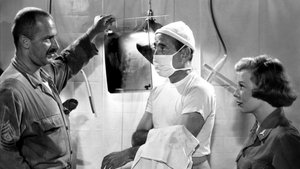Contact: [email protected]
Video Sources 0 Views

Synopsis

Introduction
In the pantheon of war films, few stand as stark and compelling as “Battle Circus Colorized.” Directed by Richard Brooks and starring Humphrey Bogart and June Allyson, this 1953 masterpiece takes audiences on a gripping journey through the Korean War. Now, with the release of a colorized version, “Battle Circus Colorized” enters a new era, inviting viewers to experience the intensity and emotion of war in vivid detail. In this comprehensive article, we delve into the significance of colorization in movies, the impact of technological advancements on classic films, and how the colorized rendition enhances the viewing experience of “Battle Circus Colorized.”
Read Media File Transfer Agreement: Terms and Conditions
Read FAQ
Understanding Colorization in Movies
Colorization, the process of adding color to black and white films, has long been a point of contention in the film industry. Proponents argue that it breathes new life into old classics, making them more visually appealing and accessible to modern audiences. However, purists maintain that it compromises the authenticity and artistic integrity of the original work. Despite the debate, colorization has gained traction in recent years, with many classic films undergoing the process to attract new viewers and revitalize interest in cinematic history.
The introduction of colorization technology in the 1980s marked a turning point in film restoration and preservation. By digitally adding color to previously monochrome films, studios aimed to modernize older movies and appeal to a younger demographic. While some embraced the change as a way to update classic films for contemporary audiences, others viewed it as sacrilege, arguing that it altered the director’s original vision and detracted from the historical significance of the work.
The Case for Preservation: Pros and Cons of Colorization
Colorization presents both advantages and disadvantages. On one hand, it can breathe new life into old classics, making them more visually appealing and engaging for modern audiences. By adding color, filmmakers can enhance the viewing experience, bringing out nuances and details that may have been lost in black and white. Additionally, colorization can attract younger viewers who may be more accustomed to the vibrant visuals of modern cinema.
However, detractors argue that colorization compromises the authenticity and artistic integrity of the original film. By altering the visual composition and atmosphere of the work, colorization can detract from the director’s original vision and dilute the emotional impact of the story. Furthermore, colorization may erase the historical context of the film, removing important cultural and aesthetic markers that contribute to its significance.
A Closer Look at the Colorized Version of Battle Circus Colorized
“Battle Circus Colorized,” set against the backdrop of the Korean War, follows a Mobile Army Surgical Hospital (MASH) unit as they navigate the challenges and complexities of wartime medicine. Directed by Richard Brooks and starring Humphrey Bogart and June Allyson, the film is renowned for its gripping portrayal of the human experience amidst the chaos of conflict.
With the release of the colorized version, audiences can now experience the intensity and emotion of “Battle Circus Colorized” in vivid detail. The addition of color enhances the realism of the battlefield, immersing viewers in the chaos and camaraderie of war. From the lush green landscapes to the vibrant uniforms of the soldiers, colorization brings new depth and dimension to the film, breathing new life into a classic tale of courage and sacrifice.
The Original Charm: Exploring the Black and White Aesthetic of Battle Circus
While the colorized version of “Battle Circus” offers a fresh perspective on the film, there is a timeless elegance to the original black and white aesthetic. The stark contrasts and moody lighting of black and white cinematography capture the intensity and drama of war with a raw, unfiltered quality. For purists and cinephiles, the black and white original remains the definitive viewing experience, preserving the film’s historical authenticity and artistic integrity.
The decision to colorize “Battle Circus Colorized” raises questions about the balance between modernization and preservation in film restoration. While colorization may attract new viewers and breathe new life into classic films, it also risks erasing important cultural and aesthetic markers that contribute to their significance. As audiences continue to grapple with the implications of colorization, it’s essential to consider the impact on both the artistic integrity and historical context of the work.
Comparing Versions: Color vs Monochrome
The colorized version of “Battle Circus” introduces a new dimension to the film, with vibrant hues and enhanced visuals that bring the story to life in vivid detail. The addition of color adds depth and realism to the battlefield scenes, creating a more immersive viewing experience for audiences. From the fiery explosions to the blood-soaked bandages, colorization highlights the brutality and chaos of war in a way that was previously impossible.
However, some viewers may argue that the colorization detracts from the film’s authenticity and atmosphere, diluting its impact and emotional resonance. While the vibrant colors may draw in new viewers, they risk altering the director’s original vision and compromising the historical accuracy of the work. Ultimately, the choice between color and monochrome comes down to personal preference and how it affects the overall viewing experience.
Considering Audience Preferences and Cinematic Integrity
In deciding whether to watch the colorized or black and white version of “Battle Circus Colorized,” it’s essential to consider both audience preferences and cinematic integrity. While colorization may appeal to modern audiences accustomed to vibrant visuals, it’s essential not to lose sight of the film’s original artistic intent and historical context. As viewers, we must strike a balance between embracing technological advancements and preserving the authenticity of classic cinema.
Whether watching “Battle Circus” in color or monochrome, one thing is certain: the film’s legacy will endure for generations to come. As audiences continue to grapple with the implications of colorization, it’s essential to appreciate the value of both versions and the unique viewing experiences they offer. Ultimately, the decision of whether to watch the colorized or black and white version of “Battle Circus” comes down to personal preference and how it resonates with each individual viewer.
The Journey of Restoration: Battle Circus’s Film History
The release of the colorized version of “Battle Circus” marks another chapter in the film’s storied history. Since its release in 1953, “Battle Circus” has garnered critical acclaim and earned a dedicated following among war film enthusiasts. Over the years, the film has undergone various restoration efforts to ensure its longevity and relevance for future generations of viewers.
Collaborations between studios and preservationists have played a crucial role in maintaining the film’s legacy and cultural significance. From the preservation of original film prints to the digitization of archival materials, these efforts ensure that “Battle Circus” remains accessible and appreciated for years to come. As audiences continue to discover and rediscover this timeless classic, its impact and relevance will endure as a testament to the power of cinema.
Reception, Relevance, and Legacy of Battle Circus Colorized
“Battle Circus” remains a timeless classic of war cinema, resonating with audiences for its gripping portrayal of the human experience amidst the chaos of conflict. With its compelling narrative and standout performances, the film continues to captivate viewers and cement its status as a landmark of 1950s cinema.
The release of the colorized version introduces “Battle Circus” to a new generation of viewers, ensuring its continued relevance and legacy in the annals of film history. Whether watching the film in color or black and white, “Battle Circus” remains a powerful testament to the resilience of the human spirit in the face of adversity. As audiences continue to discover and appreciate this timeless classic, its impact and legacy will endure for generations to come.
Final Verdict: Which Version Should You Choose?
In the end, the decision of whether to watch the colorized or black and white version of “Battle Circus” ultimately comes down to personal preference. Both versions offer unique viewing experiences, each with its own merits and drawbacks.
For those who appreciate the vibrant visuals and enhanced realism of the colorized version, it offers a fresh perspective on a classic film. However, for purists and cinephiles, the black and white original remains the definitive viewing experience, preserving the film’s historical authenticity and artistic integrity.
Ultimately, whether watching “Battle Circus” in color or monochrome, one thing is certain: the film’s legacy will endure for generations to come. As audiences continue to grapple with the implications of colorization, it’s essential to appreciate the value of both versions and the unique viewing experiences they offer. Whether in color or black and white, “Battle Circus” remains a powerful and poignant exploration of the human spirit in times of conflict.












